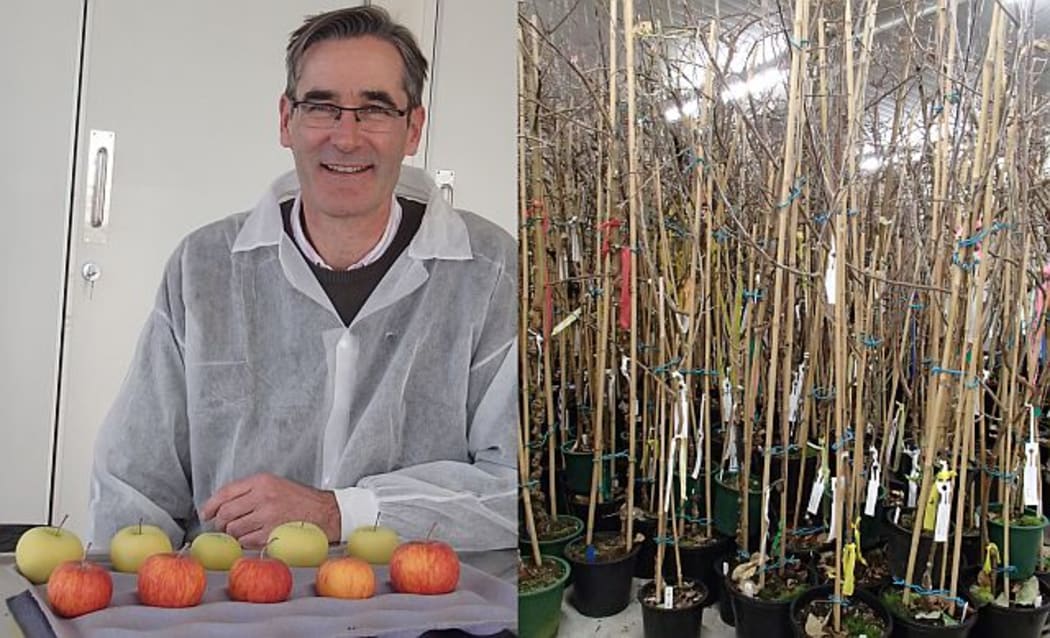
Richard Espley with a range of apples that have different co loured skin and flesh. In some cases these have the ethylene gene turned off, which slows down the process of fruit ripening. The apple trees, at right, are some of the genetically modified trees, being kept in a chiller for a few weeks to expose them to the cool 'winter' conditions that initiate flower production. Photo: RNZ / Alison Ballance
On a cold winter’s day the McLean Glasshouse on the Plant and Food Research campus in Auckland is warm and bright. So warm, in fact, that the four hundred or so experimental apple trees have been banished to the cool darkness of a basement chiller for a few weeks. Apple trees need a winter cold snap to initiate good flower growth, and when the suitably chilled trees are returned to the top floor of the greenhouse research scientists Associate Professor Andrew Allan and Dr Richard Espley hope to be busy pollinating a good crop of flowers.

Plant and Food Research scientist Andrew Allan with an apple tree, that grows like a vine, which has been genetically modified to flower for most of the year. This greatly speeds up the process of breeding new apple varieties. Photo: RNZ / Alison Ballance
They’ll be doing the pollinating themselves, because one of the features of the greenhouse – or the ‘orchard in a box’ as they like to call it – is the complete absence of pollinating insects such as honey bees. That’s because the apple trees are all genetically modified, and the greenhouse is a secure containment area with a high level of biosecurity to ensure that nothing enters or leaves the premises. All the plants grown here will be incinerated at the end of their useful research life, and it’s only the important information gained from them that will make the transition into the orchard to help in the development of new apple varieties.
The ‘genetic modification’ that takes place is helping to speed up the traditional apple breeding programme that has led to the development of many apple varieties, including the well-known Jazz. Andrew explains that Jazz is a natural ethylene mutant, and was created through the usual time-consuming method of crossing two varieties of apple (in this case, Royal Gala and Braeburn) and growing the resulting seedlings until they are old enough to produce fruit that can be tested to see if any of them possess new, desirable traits.
To speed up this traditional method of plant breeding, the team at Plant and Food Research choose one of apple’s 57,000 different genes and insert it into trial trees to see what effect it has.
“We take an apple gene and put it into apple at a very high level, and then sit back and watch what it does” says Andrew. The Plant and Food Research apple breeding programme is currently looking at about 40-50 genes which they believe are the key ones for the traits they’re interested in, such as flavour, texture, tree architecture and flowering.
To insert a gene into an apple the team takes little pieces of apple and expose them to a bacterium, called agrobacterium, says Richard.
“This is a soil-dwelling bacteria that affects plants naturally, and it does do by injecting little bits of its own DNA into the plant to get the plant to create the right growth conditions for the bacteria – very clever. Once the apple tissue has been transformed you get little apple plantlets regenerating and these are grafted onto the usual rootstock.”
Richard and Andrew describe the apple colour gene as one of their favourite genes. “It’s quite a special gene, a transcription factor that will turn on a lot of other genes, in this case involved in the anthocyanin pathway, which produces the red pigment,” says Richard. By over-expressing this gene the result is apple trees with red leaves and fruit with red flesh as well as red skin. High levels of anthocyanin are of interest as they have health benefits.
Another gene of interest is a rapidly-flowering gene, and every time the plant – which looks more like a climbing rose than an apple tree – tries to make a leaf it also tries to make a flower. This means the plant flowers for most of the year, rather than just once in spring, and the team can pollinate these flowers and produce apples for growing on whenever they want to.
“We’re talking about changing the breeding cycle of an apple from every seven years to just one year,” says Andrew. “So we’ve sped up the breeding programme seven-fold, by using this little plant.”
The team have also produced apples in which the ethylene gene has been knocked out, so that the plant no longer produces ethylene. Ethylene is responsible for ripening fruit, and a low-ethylene apple has a much longer shelf life, but will still respond and ripen when exposed to ethylene.
“What’s really exciting about these [low ethylene] trees is that we’ve been growing them for over ten years and we can do experiments with really fine control on understanding ethylene response,” says Andrew. “What happens in the first five minutes after you add ethylene, for example. We can understand all those changes and use that knowledge out in our existing apple cultivars that we have in Hawke’s Bay and all around the country.”
Plant and Food Research breed a wide range of fruit and berry crops, and Our Changing World has previously featured a story about their apricot breeding programme in Central Otago.

